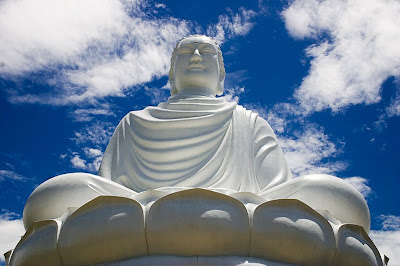

A model presents a creation inspired by the court dress of ancient China's Tang Dynasty (618-907 A.C.E.), during a show at the 2009 Qingdao Fashion Week in Qingdao, a coastal city in east China's Shandong province, 6/15/09 (Xinhua/Li Ziheng).
Many Western thinkers, who have come to know its yellow-robed monastics and have investigated the vast libraries of their quiet nunneries and monasteries, consider it one of the noblest edifices of thought ever erected by the human spirit. It is, as a whole, one of the most rational of the world's great religions [along with Christianity, which has striking parallels to Mahayana Buddhism, and Islam], for the system of human conduct that it preaches relies very little on the supernatural.
In its history, which stretches back for 2,500 years, Buddhism has bee one of the greatest civilizing forces the Far East has ever known, stimulating art and contributing profound ideas to the great Tang Dynasty culture of China in the 7th to 10th Centuries, A.C.E., and bringing civilization to Japan.
Today it is the state religion of Thailand, Tibet, Burma, Cambodia, and Laos, the dominant religion of China, Taiwan, and Sri Lanka, and a faith to which vast numbers of non-religious Chinese and Japanese turn for spiritual purpose....
Stripped of the accretions of poetic Oriental legend with which centuries of Asian imagination have surrounded it, the life of Siddhartha Gautama, or the Buddha as he was later called, is one of the great and elegant biographies of religious literature.
Mahayana Buddhism
For a while Buddhism was dominant over Hinduism. In time travelers from northern Asia, following the mountain trade routes across the Himalayas, learned something about the new religion of enlightenment and brought back reports to the cities of China.
About 65 A.C.E. a Chinese emperor, according to a legend, dreamed that a golden image of the Buddha appeared from out of the west and dispatched messengers beyond the Himalayas to find out about the mysterious source of this dream.
Indian Buddhist wandering-monks gradually made their way northward across the mountain passes as missionaries, and Chinese pilgrims traveled in the opposite direction seeking information and opportunities to worship at the shrines where Gautama had lived and taught. Two of these pilgrims became as spectacular figures in the annals of travel as Marco Polo. One of them, Fa-Hsien, left China in 399 A.C.E. and after incredible hardships in central Asia spent 15 years in India compiling an eyewitness account of that country, which is still studied by historians.
The other traveling monk, Hsuan-Tsang, left China in 629 A.C.E., crossed the Gobi desert, Sinkiang and what is now Afghanistan, spent 16 years in India and returned laden with books and manuscripts. Hsuan-Tsang subsequently translated Buddhist literature so extensively that what is ascribed to him and his pupils in Chinese amounts to more than a thousand volumes.
The court of the great Tang Dynasty, during which he lived, became filled with converts to Buddhism. Some of the greatest artists in Chinese history were devoting themselves to Buddhist subjects, and in the streets of the old Tang capital of Changan (modern Sian), Buddhist scholars could be found discussing their doctrines with Confucianists, Taoists, Zoroastrians, Manichaeans, and even Nestorian Christian missionaries from the Near East. Buddhism itself proved to be one of the hardiest of them all, and its teaching ramified into many different sects, some of which exist down to the present day.
Tang in Japan
Tantrism in Tibet
Buddhist Art
- tolerance
- nonviolence
- respect for the individual
- love of animals and nature
- a fundamental belief in spiritual equality.
It also stimulated most of the great art Asia has known. The superlative art of India (Gupta period) was predominantly Buddhist in inspiration. So was the art of the Tang Dynasty, the golden age of Chinese civilization, and much of the tradition of literature and art that Japan learned front he Chinese and finally made part of its own culture. In the south of Asia, helped by vigorous Indian trade, these concepts of ethics and art spread to Indonesia and to what are now Burma and Thailand. In the two latter countries Buddhism became so firmly rooted that these can be described today as, along with Sri Lanka, Tibet, and Cambodia, probably the most devout of all the Buddhist nations of the world.
Then after having helped spread its high culture to eastern Asia, Buddhism was displaced in India, the country of its origin. The brahmins, proprietors of the ancient and orthodox Vedic religions now collectively and loosely called "Hinduism," which Gautama had broken away from, succeeded in absorbing it. Then Muslim conquest wiped out its last vestiges in successive crusades in the north of India down to Buddhist [present-day] Bangladesh, leaving the Himalayan Buddhist kingdoms of Nepal, Tibet, Bhutan, and Sikkim largely Buddhist and isolated. Curiously, India, which gave Buddhism to the world, has contained relatively few Buddhists since the 12th Century A.C.E.
From early times the type of Buddhism practiced in China, Japan, and Tibet differed from that o f the south Asian Buddhists. This difference was due to some extent to variations in national temperament, but it can be traced back to about 100 years after Gautama's passing, when a group of disciples disagreed on the interpretation of his teaching and preached a doctrine which was less rigours and more easily adapted to the needs of the ordinary person.



















































































































































































































































